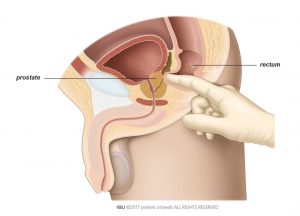The digital rectal examination (DRE) is used to check the prostate in men. It can also be used to feel the size and location of other pelvic organs. This can help diagnose changes in urination and problems with the prostate and other organs, including cancer.
DRE is done by a doctor with another health professional present as an observer. The doctor wears gloves on both hands. Using lubrication, the doctor inserts a finger (“digit”) into the rectum and then feels the prostate (Figure 1). The doctor might press the abdomen with the other hand to feel the pelvic organs from inside and outside. If pressing the organs causes pain, tell the doctor.

When is DRE carried out?
A tumor in the prostate can only be felt by means of a digital rectal examination (DRE) if the tumor has a larger volume than 0.2ml.
In 18% of patients who undergo a DRE, prostate cancer is eventually detected, regardless of the level of PSA in the blood.
A DRE in which an abnormal prostate is felt, brings an increased chance of a higher Gleason score and is an indication to do a biopsy.
What are the side effects and risks?
A DRE has no side effects. The risk is that the doctor’s finger can not touch all sides around the prostate, so something can easily be missed.

